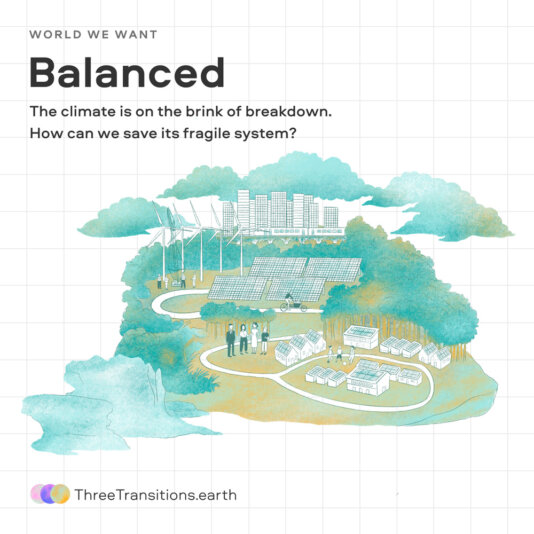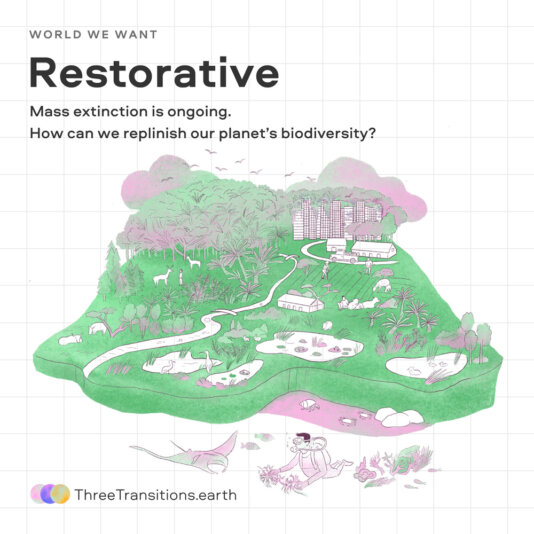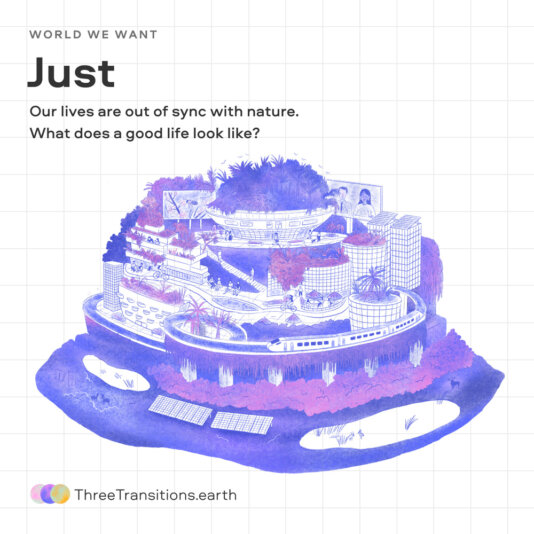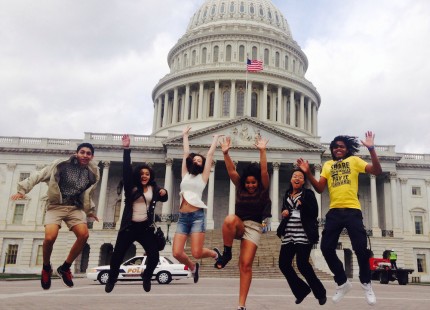- About
- Topics
- Picks
- Audio
- Story
- In-Depth
- Opinion
- News
- Donate
-
Signup for our newsletterOur Editors' Best Picks.Send
Read, Debate: Engage.
| December 20, 2021 | |
|---|---|
| topic: | Climate Change |
| tags: | #climate crisis, #climate action, #education, #art, #COP 26 |
| located: | Japan, United Kingdom |
| by: | Abby Klinkenberg |
COP26 is long gone: its initial pomp and circumstance were first replaced by half-hearted declarations that don’t go far enough and then, ultimately, by silence.
Apart from hollow words and complex questions about how to move forward, very little remains from the conference that sought to put an end to the climate crisis. Very little remains, that is, apart from an interactive web experience designed by Japanese corporation Hitachi and design innovation firm Takram - ThreeTransitions.earth.
As Director and Creative Technologist at Takram Yosuke Ushigome, who offered creative direction for the project, explains: “it’s one of the only things that you could see after COP26.”
The project is visually striking and conceptually ambitious: it details three “transitions to sustainable futures” - (1) Climate: from disastrous to stabilised, (2) Biodiversity: from destructive to restorative, and (3) Human Life: from extractive to just. Providing robust and pragmatic insights into how to practically work towards a healthier relationship between humans and nature, the website takes viewers through an immersive experience complete with an ethereal audioscape and salient visuals (including caged birds, smog-emitting smoke stacks, and a group of old white men in suits). Building bridges between the “world we have” and the “world we want,” ThreeTransitions.earth presents viewers with a series of urgent questions - such as “How can we make our energy systems fully renewable?” - and offers preliminary answers in the form of concise “breakthroughs” accompanied by links to “further reading.” It serves a primarily educational function, bringing audiences into a cautiously optimistic space in which thorny questions have achievable solutions.
In the ThreeTransitions.earth universe, it seems that things can be as easy as deciding what we want and working towards it. As simple as it sounds, it might just be the best option we have.
In conversation with Yosuke Ushigome and Senior Researcher at Hitachi’s Center for Social Innovation Koji Sasaki, who is responsible for the project’s vision and research concept, FairPlanet asked about the project’s origins, its politics and how it can help humanity towards a more sustainable future.
In addition to holding his work with Hitachi, Sasaki is also a respected academic at Keio University in Tokyo. Situated between scholarship and business, he sees himself as guiding Hitachi in a direction that better serves the public interest: “I've been trying to use my [academic] background as a kind of a resource for Hitachi […] I am trying to collaborate with the company to make a better impact on society as a whole.”
Notably, Hitachi recently received the highest possible “A” grade in climate and water usage from global environmental non-profit CDP. Compared to other corporations of its reputation and stature, Hitachi is leading the way in corporate social (and environmental) responsibility, evidenced by its status as principal partner of COP26.
Ushigome, whose work sits at the intersection of technology and design, also brings a decidedly public-service orientation to his work. “I'm trying to use design and prototyping using technologies not to create next year’s products but to help people make better decisions about our futures,” he told FairPlanet. “I'm using design as a means of… furthering discussions, specifically focusing on the intersection between sustainability, interaction design, and futures research.”
Sasaki, who sought out Ushigome’s collaboration to support Hitachi’s “Sustainability Transformation Initiative,” sees design as critical to the future: “We have to switch our view from human-centered design to a something larger than that: we have to design a better relationship between humans and nature. That's the key question that has been always motivating this project.” The pair decided upon a proactive approach, one that offers something beyond criticism: “we want to build something more positive, affirmative, more constructive.”
Central to their constructive approach is the notion of “transition,” which could leave a bad taste in the mouth of those who demand a more radical transformative approach to the climate crisis.
However, Sasaki and Ushigome “don't see transformation and transition as necessarily contradictory or fundamentally different.” Their commitment to the idea of transition resides in its form: “even if it is a radical transition, there's a process and there are concrete steps.” Emphasising that “you always need to start with what you have already,” Sasaki continues: “To me, transition sounds a little more about the steps and pathways to make something happen […] we used [this word] to sort of show people that there's a better version of our world. And we want to picture the kind of steps or pathways as a process that takes us to achieve that.”
Ushigome agrees: with transition, “there's a room for people to imagine the in-between stages in the world transition, not to say that we can stop in between or that we should, just that there is a scope for people to have discussion […] whereas what people imagine from words like ‘revolution’ and ‘transformation,’ like very quick shifts, there’s no scope for that.” Speaking from his position as creative director and bringing in his eye for design, he adds that “transition [rather than radical transformation] carries more opportunities for much richer, complex and nuanced visuals and images to be created.”
While their collaboration began prior to the pandemic in late 2019, the COVID-19 crisis inspired Sasaki and Ushigome to expand their work in the wider direction of futures. “At the end of 2020 […] we were thrown to a reality so unknown to us, like, we didn't know what to do with it,” says Sasaki, “so we were thinking […] that now was the time for us to really shed a light on the kinds of futures that we want,” which led them to “research about the transitions that we need to make.”
Their joint research eventuated in “Transitions to sustainable futures,” which integrated striking design with dense informational texts about nine urgent transitions needed to move towards a greener future. While feedback was positive, “sometimes I got the reaction that they wanted to see something rather than reading,” says Sasaki. “They wanted to see something,” he continues, and this feedback spurred the duo’s desire to move towards a more visual and interactive space - it was “the genesis” of ThreeTransitions.earth.
Entering the website, one is struck by its clean graphics (bold and streamlined design), grand rhetoric (“we urgently need a new vision”), and engaging UX - one might also be struck by its projected simplicity.
Any work that purports to translate the complex world of climate policy into accessible and everyday language risks erring into the reductive. Tying up the world’s climate ills in three transitions while doing justice to the problems we’re facing is a challenge that Sasaki and Ushigome took up with sensitivity: “We kind of wanted to make things simple, we wanted to make it easily digestible and understandable. Talking about actions and stuff like that […] required a lot of sensitivity: who reads this, the audience, their backgrounds, where they're coming from, their struggles, and [the] difficulties [they face] to move towards sustainability even though there is the will […] those things need to be accounted into the design and the language."
“I hope that we hit the right balance. It's evocative and intrusive enough for people to get the first couple of lines and then kind of get what it's trying to say," He added. "But also you can dig deeper and get much more engaged in the content. So that's what I'm happy about and what we hoped for.”
That kind of sensitivity extends to the political sphere, as well: curiously, the website does not include explicit references to any ideologies - the word “capitalism” is conspicuously lacking, particularly in when discussing the “extractive” “world we have.”
Ushigome offers that “there are kind of particular ideologies that we tried not to mention and tried to avoid vilifying.” A desire not to alienate any actors is central to their approach, as Sasaki explains: “we tried not to be ideological."
"I had to ask for many, many revisions of certain sentences and certain words that we use […] As an anthropologist, I have a very critical view on capitalism […] but I’m not just an anthropologist, I also work with the world of business and industry," he said. "I know that, more than any anthropologist wants to believe, maybe, that there are so many people who are in the businesses that are trying to make better impacts on the world […] I didn't want to picture businesses as a monolithic thing. And I wanted to emphasise the many roles that businesses can play to fight climate change - but it's not pro-business or anything.”
Ushigome shares that they chose to consider “how people react to the contents and how that might potentially [have] a negative impact on furthering discussion, that's the kind of thing that we tried to incorporate and have tried to think through but, of course, we are not perfect, and we must have made some mistakes that we are not even aware [of]. And then I'm super curious how people from different backgrounds [respond] to the contents themselves, but also the tone of language, tone of visuals used to tell those stories and the contents - very, very curious to hear.”
Ultimately, as ThreeTransitions.earth moves from a relatively small audience at COP26 to the public at large, Sasaki and Ushigome hope that the website will act as a meaningful starting point for conversations around how humanity can better respond to the climate crisis.
Sasaki details this aspiration with passion: “we want this transition thinking to become a common language [for people] to view this current world and have dialogues with anyone around them, and to imagine what the possible better version of our life is in terms of nature and society.” He hopes that those who engage with ThreeTransitions.earth to “see themselves in that map and [identify] what they can do [to make] that transition from the current system to another system.”
For his part, Ushigome would like to move beyond the project’s educatory intention (“it is a kind of interactive experience, but you still receive information - primarily, that's the mode of interaction”) and “work on some sort of creation of tools for people to engage with a concept […] How could we facilitate the conversation between multiple people who have access to this content at the same time? Or how could we make these contents much more accessible to younger audiences? For example, how could we use this in educational settings and contexts and schools? These are the kind of avenues that this can go. And I'm pretty excited about those possibilities.”
Image by Takram / Hitachi



By copying the embed code below, you agree to adhere to our republishing guidelines.

